In the paper "The Riemann Hypothesis" by J. Brian Conrey in figure 6 there is a plot of the Fourier transform of the error term in the prime number theorem. See the plot to the left in the image below:

In a blog post called Primes out of Thin Air written by Chris King there is a Matlab program that plots the spectrum. See the plot to the right at the beginning of the post. A translation into Mathematica is possible:
Mathematica:
scale = 10^6;
start = 1;
fin = 50;
its = 490;
xres = 600;
y = N[Accumulate[Table[MangoldtLambda[i], {i, 1, scale}]], 10];
x = scale;
a = 1;
myspan = 800;
xres = 4000;
xx = N[Range[a, myspan, (myspan - a)/(xres - 1)]];
stpval = 10^4;
F = Range[1, xres]*0;
For[t = 1, t <= xres, t++,
For[yy=0, yy<=Log[x], yy+=1/stpval,
F[[t]] =
F[[t]] +
Sin[t*myspan/xres*yy]*(y[[Floor[Exp[yy]]]] - Exp[yy])/Exp[yy/2];
]
]
F = F/Log[x];
ListLinePlot[F]
However, this is as I understand it the matrix formulation of the Fourier sine transform and it is therefore very costly to compute. I do NOT recommend running it because it already crashed my computer once.
Is there a way in Mathematica utilising the Fast Fourier Transform, to plot the spectrum with spikes at x-values equal to imaginary part of Riemann zeta zeros?
I have tried the commands FourierDST and Fourier without success. The problem seems to be that the variable yy in the code is included in both Sin[t*myspan/xres*yy] and (y[[Floor[Exp[yy]]]] - Exp[yy])/Exp[yy/2].
EDIT: 20.1.2012, I changed the line:
For[yy = 0, yy <= Log[x], 1/stpval++,
into the following:
For[yy = 0, yy/stpval <= Log[x], yy++,
EDIT: 22.1.2012, From Heike's comment, changed:
For[yy = 0, yy/stpval <= Log[x], yy++,
into:
For[yy=0, yy<=Log[x], yy+=1/stpval,
